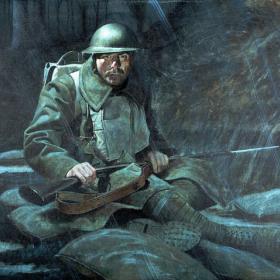And They Thought We Couldn't Fight - Victory Liberty Loan
Forsythe, Victor (1885-1962) 1919 Lithograph
On October 5, 1918, the German government sent a message to President Woodrow Wilson to begin the negotiation of terms to end the war. However, the United States called for the abdication of the German Kaiser before negotiations could begin. The Kaiser refused. A month later, after continued fighting and bloodshed, on November 5, 1918, the Allies acquiesced and agreed to begin negotiations for a truce. On November 8, 1918, the Allies handed a German delegation a list of demands and 72 hours to agree. An Armistice was agreed upon with a cease-fire starting on November 11, 1918, at 11 A.M. Hoping to strengthen their standing during the peace negotiations, both sides continued fighting right to the moment the time the ceasefire began.
Although the Armistice ended the fighting, a peace treaty between German and the Allies was not signed until June 28, 1919. The Treaty of Versailles, which formally ended the war, required Germany to make substantial territorial concessions, pay reparations, and disarm. Under the stress of paying the reparations and recovering from the war, the German economy collapsed. The treaty became the basis for widespread resentment in Germany and created a nationalistic backlash which fueled the rise of the Freikorps and, eventually, the Nazi party. In the twenty years following the signing of the treaty, it was used to rally support for a renewed war against Germany’s perceived oppressors.
The German allies of the Austria-Hungary and the Ottoman Empire collapsed and broke into smaller nations. Russia suffered from a civil war which began in 1917 with the Bolshevik Revolution and continued until 1923. Several of Russia’s border territories broke away and grained independence including Lithuania, Latvia, Estonia, Finland, Armenia, Georgia, and Azerbaijan.


